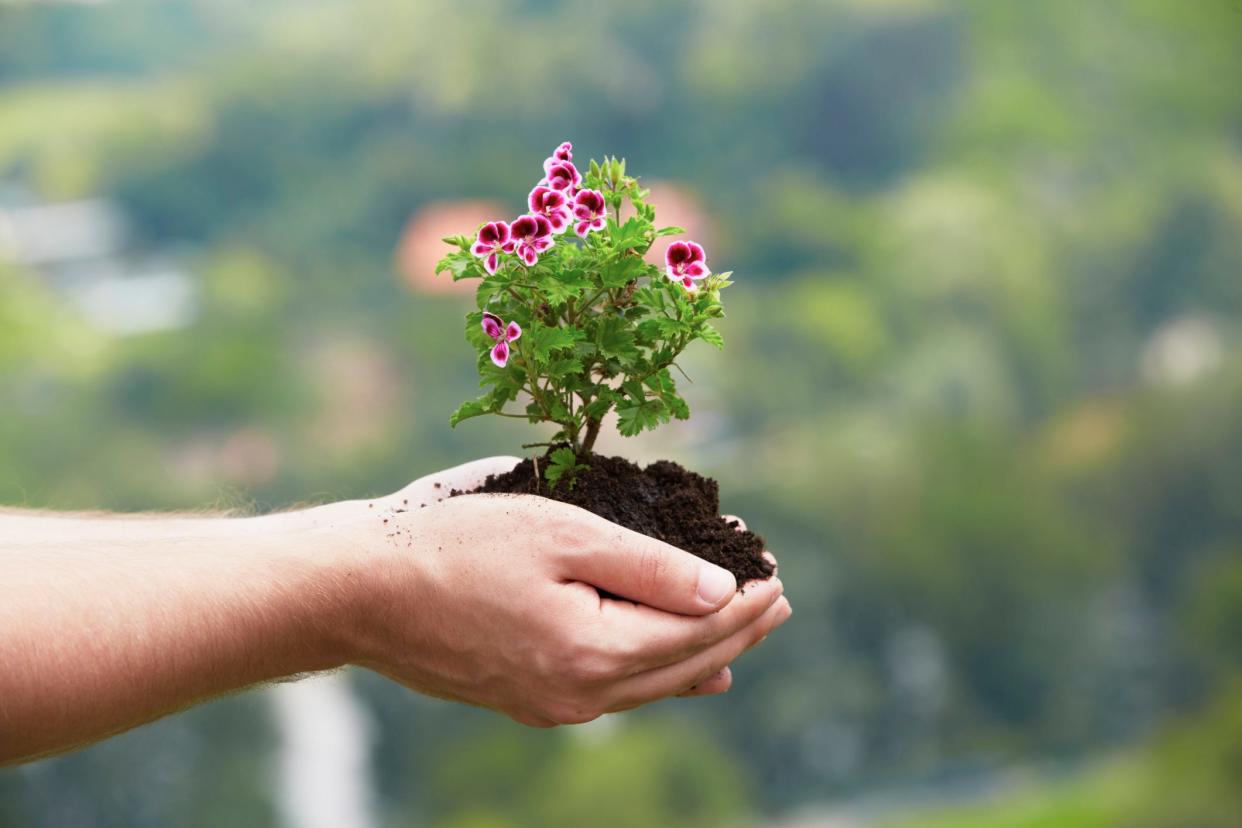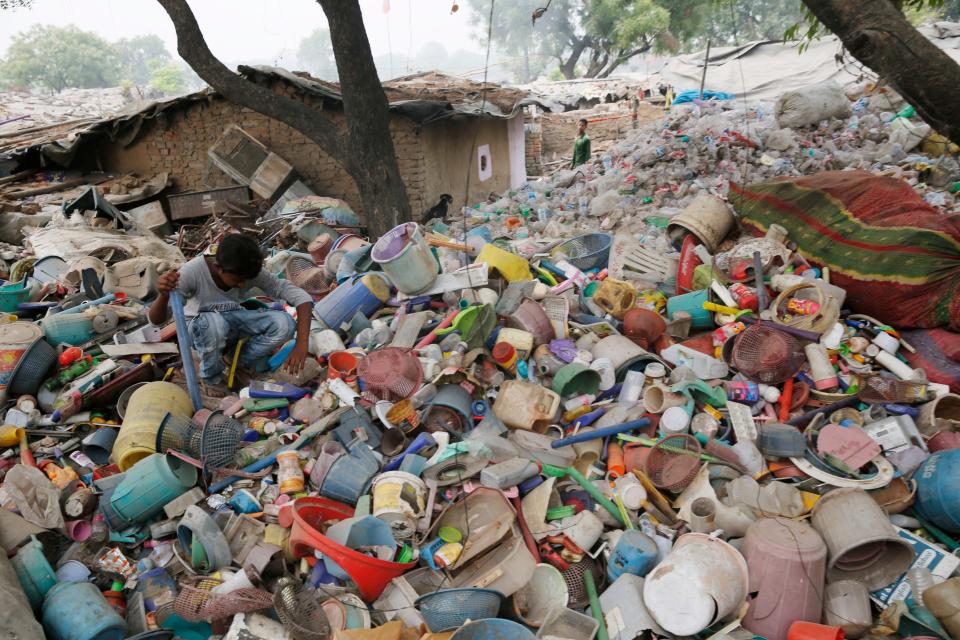We can’t purchase our way to a cooler climate, experts say. Not even on Earth Day

This might come as a surprise, but a lot of environmental journalists dread Earth Day. After chronicling the harm being done to our home planet all year, offering awareness and understanding day in and day out, it can feel like a mockery of a dire and constant problem when the crowds emerge on April 22 to celebrate the Earth, many of them buying and selling T-shirts or trinkets.
Earth Day is also when the greenwashing of my email inbox is the worst.
For the past several weeks, I’ve received an average of two to three emails per day pitching me a story idea about some new, sustainable product or initiative readers will surely want to know about as part of my Earth Day coverage. Sometimes the reasoning behind labeling a product as “green” is laughably stretched or flawed. Other times, the Earth-friendly score of whatever innovation is being pushed is less clear.
Greenwashing is the term for marketing schemes that attempt to present a product as eco-friendly, sustainable, or otherwise good for the environment (and therefore guilt-free), when in reality the benefits are unclear, unquantified, minuscule or missing the point. It’s the practice of leaning into the status quo of capitalism by preying on the public’s growing — but sometimes misguided — desire to be part of the climate solution and do better by the environment.
“This is something that is critical if we’re trying to address consumption patterns,” said Nicole Darnall, a professor in the School of Sustainability at Arizona State University and a co-founder of its Sustainable Purchasing Research Initiative.

Several years ago, the Federal Trade Commission identified the area of greenwashing and green products as the number one source of consumer misinformation. They developed guidelines to “pull in the reins in terms of what information companies can put out there,” Darnall explained. She even thought the guidelines were decent. But she's seen little enforcement.
“There’s no teeth in this. What incentive does a company have to be truly honest? There are at least 450 eco-labels in the marketplace today. Even the most motivated consumers would struggle to find the time to make sense of all this.”
A quick tour of a climate or environment writer’s email leading up to Earth Day illustrates the problem.
Awash in green (maybe) ideas
In March and April, I received dozens of advertisements to my Arizona Republic inbox, some of which I've roughly categorized here into 5 different types of greenwashing. It's not necessarily the existence of these types of products or ideas that is the problem, according to experts like Darnall, so much as the Earth-Day-focused marketing, the justification for which often isn't clear or regulated.
1. Oversimplified non-solutions
One email calculated how many trees major companies would need to plant to offset their carbon emissions.
An energy drink company has revolutionized its packaging by making a resealable lid that touts advantages “from making energy last longer to creating less waste.”
Another company is offering to solve the climate issue of packages getting stolen off porches and having to be replaced by using drones to securely deliver mail the last mile to its destination.
A QR code generator wants to save tress by selling digital business cards, but responded to emailed questions that they had not calculated the energy balance of creating, sharing and viewing these on screens.
2. Companies that completely miss the point
A Canadian energy company is offering “a more sustainable fracking method.”
A car racing team is sponsoring a DIY oil clean-up before a 500-mile race, for which “fans across the country are invited to join in the efforts by posting pictures to Instagram of their own clean-ups for a chance to win a race-worn, fire suit.”
3. Products with unclear benefits or ties to sustainability
One company is making “the world's first plant-based salt that can reduce sodium intake by 40%” and is good for high blood pressure.
Another company is going to protect subsistence farmers from climate change by allowing them to use blockchain to secure insurance for weather events.
A digital fashion company has created a video game to reduce waste by helping consumers “only purchase physical pieces they already feel they know and love.”
An email titled “Earth Day products for the whole family” advertises face wipes, baby clothes and hand sanitizer that is somehow earth-friendly in addition to being a “new vegan, moisturizing, nourishing and germ-killing experience.”
4. Advertising schemes that emphasize eco-friendly aspects of their product while ignoring the bigger picture
An emailed fact sheet outlines the cooling, health and carbon-capture benefits of natural turfgrass over plastic lawn coverings while ignoring the West’s drought crisis and options for native-plant landscaping.
One company advertises packaging modifications that “eliminate the need for brands to label their containers with a separate plastic wrapper” to improve recyclability while ignoring the general dysfunction of our recycling system.
5. Ideas that feel close to being actual solutions, but seem to come with a catch
A furniture company is offering to pick up and donate lightly-used furniture to Habitat for Humanity in an Earth Day program that last year helped to keep “2.4 million pounds of furniture out of landfills.” But in order to participate, customers must buy new furniture from them this week.
A offer to interview the author of a new book about health risks of microplastics adds that she can also speak about her company that “features plastic-free packaging and containers, in order to help people to start weeding unnecessary plastic from their lives,” which sounds a lot like product options we all already have.
All mixed in with what might be some good ideas, research pending
One company says it is developing algae-based Omega-3 supplements to reduce harmful krill fishing.
Another company that develops and finances utility-scale solar offered an interview on how the U.S. can further scale up our energy independence in 2022.
Can we clean up greenwashing?
Darnall says that, although the government isn’t keeping up with enforcement of product marketing guidelines, the Environmental Protection Agency has put out a list of preferred eco labels that they determined meet some standards for sustainability. It’s not comprehensive and admittedly favors their own labels, like Energy Star and Water Sense, she said.
“But in general, it’s a reasonable guide. If what we’re trying to do is shift consumption decisions — either consumers at the cash register or individuals who are looking to invest in green companies — if they don't have valid information, information they can trust, they're less likely to make that decision. And so what it does is it really penalizes companies that are blazing trails, that are advancing sustainability."
How to learn more during Earth Week: ASU to dedicate $192 million sustainable facility amid full slate of Earth Week events
Other lists offer consumers multiple ways to vet sustainable product claims. Morningstar investment firm, for example, went through all of its companies that identified themselves as being ESG-forward, which signifies an evaluation of responsible practices in environmental and social governance.
They ended up de-listing 1,200 funds, about 20% of their total, because of greenwashing misinformation.
“The more players that we get into this space that are monitoring and critical of how companies are marketing themselves, the better,” Darnall said. “It’s not a complete solution, but it’s going to help.”
Consumers can also do a bit of digging on their own to assess, to some degree, the likelihood that products advertised as environmentally-friendly actually are. Darnall says that, in general, the best eco labels are the ones sponsored by nonprofits. Next best are those backed by government agencies. The least reliable tend to be those that are created by industry, because they carry the lowest expectations for environmental performance.
This does not apply to all companies, of course. But the rules of capitalism do suggest that consumers voting, with their dollars, for more transparency in sustainability fact-checking may help bring more clarity to the situation.
To avoid getting swept away by enthusiasm for exposing companies sweeping their practices under a green rug, it’s important to note that none of this is a clean sweep solution. The most recent report from the Intergovernmental Panel on Climate Change spelled out the need for massive transitions away from fossil fuels and carbon emissions, and toward electrification, as the main actions necessary to curb impacts.
The IPCC report: Climate experts say the world 'is at a crossroads,' but offer hope with concrete actions
Darnall thinks the greenwashing flood also detracts from important discussions about how we can reinvent our food system while respecting the personal choices that go into what people eat.
“I feel that the conversation is still full of a lot of distractions,” Darnall said. “If we want to create fundamental change, we should be thinking about the food that we consume. There’s a whole bunch of things that make processed food very energy and water intensive and expensive for the environment.”
Rule of (green) thumb
When trying to swim through a sea of fake-green products, a good rule of thumb may simply be this:
If it feels like a climate solution gimmick, it probably is.
The world’s top climate scientists have been saying essentially the same thing for decades: we need to limit emissions and transition to renewable energy. Every few years, a new 3,000-page report explains it in increasing detail. But the general message is unchanged.
More: The power of the sun, of the people and of politics. The climate depends on all 3
While innovation is certainly needed, actual solutions to climate change are not going to hit your inbox one day like a Nigerian prince with a life-changing offer. Real progress will come from consistent, conscious, comprehensive change, just like those real life hacks we all know about even if we don’t always practice them: packing a lunch to save money rather than planning on a get-rich-quick payday, actually going to the gym every week past January or working on your glitchy relationship instead of just trading in for a new one.
Like the Nigerian prince’s claim, though, the chance to mitigate warming actually is a once-in-a-lifetime opportunity. We have to take it.
So, save money and the planet by packing conscious lunch choices in containers you already own, unplug something in your house on your way outside for some exercise and tell your loved ones why you like them and that you want to install some solar panels together.
If you have a personal story, rather than a product, you'd like to share about struggling to be a green spender, please email me. Make sure to also get out and enjoy the Earth this Friday, and every day.
Joan Meiners is the Climate News and Storytelling Reporter at The Arizona Republic and azcentral. Before becoming a journalist, she completed a Ph.D. in Ecology. Follow Joan on Twitter at @beecycles or email her at joan.meiners@arizonarepublic.com.
This article originally appeared on Arizona Republic: Greenwashing obscures the need to protect the Earth every day.

